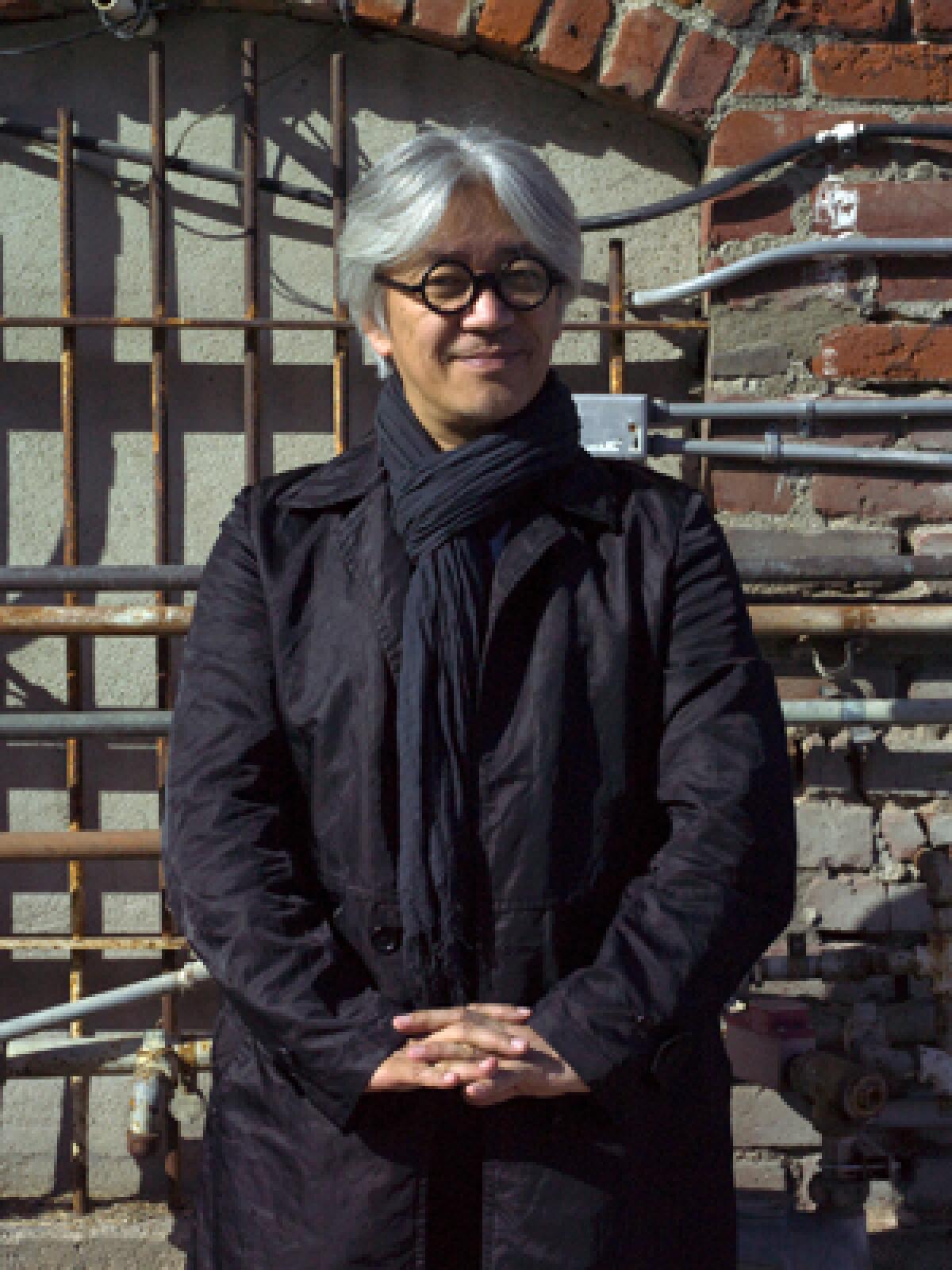Ryuichi Sakamoto marries ambient sounds to music

Music and noise, art and politics, sound and vision: Composer, musician, occasional actor and environmental activist Ryuichi Sakamoto says we’re living in a world in dire need of reconciliation.
Sakamoto, who performs at El Rey on Friday, is best known as the founding member of Japan’s genre-defining techno- pop band Yellow Magic Orchestra who went on to great acclaim as the composer of film scores including “Merry Christmas Mr. Lawrence,” “The Sheltering Sky,” “The Last Emperor,” “High Heels” and many others.
Lesser known are Sakamoto’s valuable contributions toward bridging the gaps between high and low music with groundbreaking sounds across many genres, including Brazilian samba, hip-hop, jazzy pop, piquant world-music and new-music explorations in the realm of pure electronics.
Sakamoto’s new double CD, twin-titled “Playing the Piano and Out of Noise” (Decca), showcases his highly personalized odyssey to find the elusive boundary between music and noise.
“I have done many projects,” he says, “some that were originally symphonic, and then I’ve done piano solo or piano trio settings, which is just another sound. This time I worked the most simply, as a piano solo.”
While all of the songs on “Playing the Piano” were originally written on the piano –– these comprise reworkings of Sakamoto’s familiar themes from “Merry Christmas,” “The Sheltering Sky” and “The Last Emperor” as well as selections from his YMO and solo-album repertoire –– the “Out of Noise” material was electronically originated, making their re-interpretation a little more difficult.
“The first group was pretty easy to do,” he says, “because I wrote those pieces on the piano, so it was kind of going back to the very seed of the creations. And this other group was a bit hard, because I had to re-arrange electronic music for the piano.”
Sakamoto has been touring Japan and Europe the last couple of years with his new piano experiments, often in collaboration with electronic musicians Alva Noto and Christian Fennesz. He now brings his rather Olympian undertaking to North America, in a format in which the varied strands of his music have been arranged for piano duet –– so to speak. In fact, the concerts are performed via two pianos, one played by Sakamoto and a second that interacts with Sakamoto’s playing via MIDI controller, creating the effect of a piano duo.
For Sakamoto, making music now is less and less about note-spinning and far more about the possible worlds between the notes, or where the notes go when they decay into silence. “I want to listen to the tones of the piano, in each harmony,” he explains.
This is heard to chillingly beautiful effect on the “Out of Noise” half of the new album. The idea of combining acoustic piano, digital effects, and ambient sounds germinated when he’d prepared a batch of piano improvisations for Noto to electronically manipulate for an album project together.
“I played one note or one harmony,” he says, “and then I waited until he responded to the harmonies; then I waited –– plenty of silence –– then hit another note or harmony. He would then again manipulate or control each note or harmony. By doing that I was discovering, or looking to find, the boundary between sound and noise.
“But,” he says with a wry grin, “it’s almost impossible to find. When the piano sound is ringing, it’s disappearing into noise, and you cannot define the separation line.”
“Out of Noise” was conceived partially in Greenland, where Sakamoto had been invited by the environmental organization Cape Farewell as part of a program for artists and scientists to witness firsthand the front line of global warming. Armed with a hydro microphone, Sakamoto took advantage of a potentially interesting sound opportunity, recording underwater sounds in the Arctic Sea.
“It’s a very noisy world underwater,” he says with gleeful awe. “You cannot know what these sounds are –– many currents, whales, unidentifiable things. Again I found this concept of creating music by listening to noise.”
The album’s spellbinding interface of piano, found sounds and digital processing suggests a kind of reunion between the human and alien, the organic and inorganic, the ancient and the future. Sakamoto brings all these together with superbly crafted form in “Tama,” within which one hears this very strange crystalline sound, a mixture of an old Japanese reed instrument called sho and a percussive thock! derived from striking a piece of charcoal.
“As I get older,” he says, “I want to hear more detail in music. I want to hear music deeply, in a meditative way, because I’m getting close to death.” He laughs. “Music’s not only the designs of sounds, or its patterns, but to convey something. Something you cannot express with words.”
He’s quite clearly articulated, however, when he discusses his concerns for the future of life on Earth. Sakamoto has long been a highly vocal activist concerned with militarism, nuclear proliferation, economic exploitation of the Third World, the environment, geopolitical issues and intellectual-property rights. These efforts as well as his eco-friendly touring plan (which includes a carbon-offset credit paid for by his More Trees foundation, which is reforesting in Japan, Vietnam and the Philippines) were honored with the Echo Award for the Most Innovative Musician and Musical Tour 2009 at the United Nations Environment Programmes Echo Festival in conjunction with World Environment Day.
Thankfully, Ryuichi Sakamoto is not one to splash his politics onto his music, which remains probing, vital and keenly un-literal-minded — and, no surprise, increasingly relevant.
“We have to do what we can do for the next generation, and other generations to come. Otherwise someone we love will have to live in a harsh environment. I don’t want that.”
More to Read
The biggest entertainment stories
Get our big stories about Hollywood, film, television, music, arts, culture and more right in your inbox as soon as they publish.
You may occasionally receive promotional content from the Los Angeles Times.









